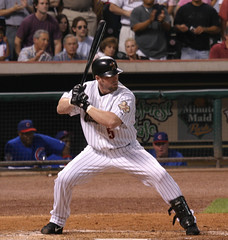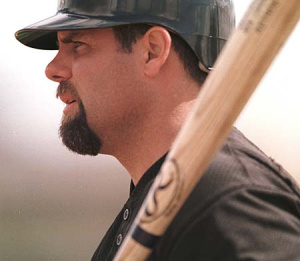South Park is one of my favorite programs on television these days. Trey Parker and Matt Stone trash everyone. So, while I may bristle somewhat at the fact that they trash my church or heritage, I chuckle because they trash everyone. In particular, they have managed the almost impossible feat of making Satan a sympathetic figure. In the same way, it has become an American tradition to make certain groups sympathetic when they otherwise wouldn’t be. In the 1600s it was eccentric women in Salem. In the 1950s it was people that may have had left leaning political beliefs. In the 2000s, it is baseball players that hit home runs under suspicious circumstances. Scapegoating and hysteria is an American tradition.
Hopefully, when you are done reading this you will check out The Hall of Fame Index at Amazon or Barnes and Noble.com. I spent nearly ten years working on it. I changed the formula at least three different times. I looked for traditional publishers and finally settled on IUniverse (a self-publishing company). You can also check out the book on their site. Many might assume I want a Hall of Fame vote. I wouldn’t mind one, but that wasn’t what the book is all about. Others may assume I want the voters to pick my Hall of Famers. That would be great too, but that wasn’t the purpose. The real purpose was to get voters to think more about what they are doing. They need to care as much as some of us do.
I hate calling out writers, but I have to in this case. Jeff Pearlman almost single-handedly made juicers sympathetic. I thought that was impossible. Like Satan and South Park, I thought they were forever banished to the island of misfit toys. Of course, the juicers themselves aren’t really that sympathetic. In most things, it is never that simple. It is folks like Pearlman that make it that simple. In doing so, they insult our intelligence and just make themselves look like jackasses.

- Image by av8pix.com via Flickr
As a native Houstonian, I am most concerned with the “case” he made against Jeff Bagwell, but this treatise would easily be applicable to similar players. Allow me to walk through his argument one by one to really demonstrate how blatantly stupid it really was. I hate to give Pearlman anymore pub than he deserves, but these arguments are made by many, so they deserve some mention.
His Numbers Shot up
The funny thing, this is the most compelling of all of the arguments. Jeff Bagwell never hit much more than ten homers in the minors and won the ROY award with 15 home runs. He would eventually hit 47 as a career high. Of course, those numbers came in Minute Maid Park after a career in the Astrodome. I’ll admit, it is unusual to see that much power with a paltry minor league total, but it has happened before. If Pearlman had offered any other compelling evidence he might have had something.
He got bigger
The funny thing is that this is the kind of argument that sounds good on the surface. It’s used against Bonds, McGwire, Sosa, and most other sluggers. In some cases, it appears to be compelling and in other cases it’s just window dressing. I’ve put on weight since college. I’m reasonably sure some it may even be muscle. I guess I oughta get tested. It’s an absurd example I’ll grant, but so is an argument built on something that happens naturally to most players over time.
He broke down at the end of his career
This one is akin to the question of when you stopped beating your wife or girlfriend. There is no way to answer this one. Most players break down. So, you could just as easily ask a Barry Bonds why he didn’t break down in his late thirties. So, you simply take the result and frame the question to match the result. Bagwell did break down around the time when testing began. He couldn’t lift weights because of his shoulder condition so he also got smaller. See, add two asinine arguments together and you get a seemingly compelling case. Pretty tricky isn’t it?
He associated with other users

- Image via Wikipedia
This is actually my favorite. Bagwell was on the same team as Ken Caminiti and Jason Grimsley. This is according to Jeff Pearlman’s crack research staff. Pearlman needs to fire his fact checker. Grimsley was acquired in the Curt Schilling trade. He was out of options so he was released when he didn’t make the 25 man roster. So, he technically was never a teammate outside of spring training. However, let’s suspend disbelief for a moment. Let’s say that Jason Grimsley offered Bagwell steroids in that five week time period they were together. Grimsley held one NL record: the most wild pitches in an inning. So, he approached the reigning NL Rookie of the Year and said, “I was so terrible I set the record for wild pitches in an inning. I know you are the reigning rookie of the year and all, but I’ve found that these have enabled me to achieve high levels of greatness to date.”
Allow me to offer an otherwise more plausible explanation. Both Caminiti and Grimsley used steroids after they were in Houston. By Pearlman’s own foolproof test, they got bigger and saw an increase in performance after leaving Houston. Sure, Bagwell and Cammy remained friends. I have no idea if he and Grimsley even spoke let alone remained friends. This is all true, but by the same seven degrees of a Kevin Bacon test we can link any big leaguer to steroids. If we try hard enough we can get Bob Feller busted for HGH. Ridiculous? Sure, but he knew a guy who knew a guy who knew a guy that did HGH.
We all know Houston and Arlington were ground zero for steroids

- Image via Wikipedia
Really? You’ve got to be pulling my leg now. I didn’t know Pearlman was a comedy writer. Usually, the phrase “we all know that” is a precursor to an argument someone can’t possibly defend. How exactly did the Mitchell Report miss that one? Ask even the most casual of fans about the origins of steroids and they would point to the Bay Area. So, obviously we all don’t know that nugget Pearlman. Perhaps you can offer a shred of evidence of the countless Rangers and Astros that used steroids or HGH. This is how he lumps Craig Biggio into the discussion too. Notice Biggio doesn’t even have to go through the same exhaustive logical chain of tests Pearlman used on Bagwell. He played in a hotbed of steroids so therefore he must have used steroids. Case closed.
The damage has been done
Could Jeff Bagwell and Craig Biggio have used performance enhancing drugs? Anything is possible. Bagwell admitted to using Andro during his playing career before it was put on the banned substance list. So, it isn’t necessarily an illogical leap to wonder if he used other drugs. There is a difference between reasonable suspicion and a preponderance of evidence. It is reasonable to suspect almost everyone from the era. That is the burden that today’s voter must live with. Still, the general public and BBWAA themselves must be able to separate those that have tested positive, were mentioned in the Mitchell Report, or are blatantly obvious with those that could have possibly used.
Unfortunately, that might not be possible now. Enough columnists and bloggers have put Bagwell in that first group that he may not get in. I’d be willing to bet that he does, but there is enough doubt to make that more difficult. He isn’t the only one in that boat. Therefore, these players become sympathetic figures with writers that seem to use the National Enquirer rules for journalism ethics. If you throw enough crap on the wall some it is bound to stick. When it does Pearlman will be the first to claim credit. If it doesn’t, he will be quietly whistling and backing out of the room.



